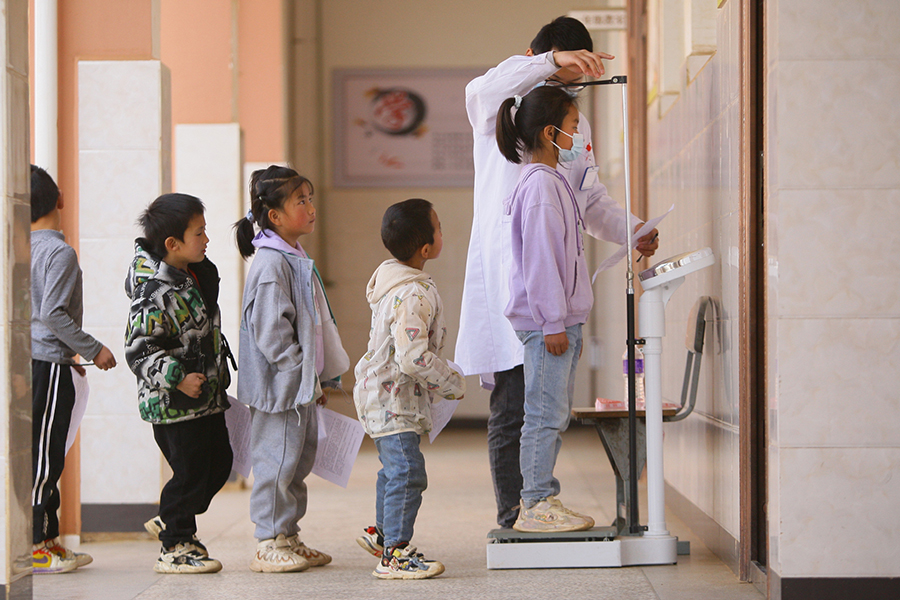
A newly released guideline for lipid(脂质) management stated that blood lipid testing should be included in routine physical examinations for primary and middle school students in the country. The new guideline is a major adjustment after seven years since the revised version was published in 2016. Compared with the old version, it has added many new contents, especially the emphasis on including blood lipid testing in physical examinations in schools.
Statistics show that the overweight and obesity(肥胖) rate among Chinese children aged 6-17 is nearly 20 percent, with the rate among children under 6 exceeding 10 percent. Obesity and blood lipid abnormalities often occur together.
In 2017, the detection rate of blood lipid abnormalities among children and adolescents in Beijing was 20.3 percent, with a detection rate of high cholesterol(胆固醇) of 5 percent, a three-fold increase compared to 2004. In 2021, Tianjin conducted a chronic(慢性的) disease risk factor screening on 72,000 kindergarten children and 91,000 second-grade primary school students. The result showed the detection rate of obesity among kindergarten children was 11.1 percent, and the detection rate of blood lipid abnormalities was 7.4 percent. The detection rate of obesity among second-grade primary school students was 21.4 percent, and the detection rate of blood lipid abnormalities was 13.5 percent. In 2022, a survey showed that hypertension and high blood cholesterol detection rates among around 2,900 children in the first grade of 17 primary schools in Shenzhen were 23.6 percent and 11.8 percent, respectively.
A report released by the Chinese Nutrition Society shows that the consumption rates of sugary milk drinks and drinks among Chinese children and adolescents are over 30 percent and 25 percent, respectively, much higher than that of adults. Children’s intake(摄取量) of many fried foods, sweets, and sugary drinks and excessive(过多的) dependence on electronic products without enough exercise may cause irreversible effects. For example, long-term high blood lipid levels can ultimately lead to high blood pressure.
本时文内容由奇速英语国际教育研究院原创编写,未经书面授权,禁止复制和任何商业用途,版权所有,侵权必究!(作者投稿及时文阅读定制请联系微信:18980471698)
1.What can be learned from Paragraphs 1 & 2?
A The new guideline is the same as the old version.
B China attaches great importance to children’s health.
C The weight problem is serious only in teenagers.
D Obesity and blood lipid abnormalities are not related.
解析:选B。B细节理解题。根据第一段第一句的“blood lipid testing should be included in routine physical examinations for primary and middle school students in the country”和第二段提到的肥胖与血脂异常如影随形可知,我国儿童、青少年脂质异常血症发生率呈上升趋势,对此,我国高度重视,并将血脂检测列入小学、初中和高中体检的常规项目。故选B。
2.What do the statistics in Paragraph 3 tell us?
A The detection rate of blood lipid abnormalities in students is higher than the obesity rate.
B Blood lipid abnormalities in children have become a phenomenon that can’t be ignored.
C Many factors have increased blood lipid abnormalities in children and adolescents.
D The detection rate of high cholesterol has nothing to do with chronic disease risks.
解析:选B。B推理判断题。第三段这些惊人的数据都在提醒我们,儿童血脂异常已成为一个不可忽视的现象,学生血脂检测不仅必要,而且尤为紧迫。故选B。
3.Which of the following words can the take place of the underlined word “irreversible”?
A Temporary.
B Hollow.
C Absurd.
D Severe.
解析:选D。D词义猜测题。根据划线部分后面的“For example, long-term high blood lipid levels can ultimately lead to high blood pressure.”可知,儿童过多摄入油炸食品、甜食、含糖饮料,因过于依赖电子产品而缺乏运动等会对身体造成一些严重的影响,比如长期的高血脂可导致血压增高。故选D。
4.What type of writing is this text?
A A research article.
B A play review.
C A health report.
D An advertisement.
解析:选C。C推理判断题。本文报道了血脂检测列入中小学常规体检,属于健康报道。故选C。